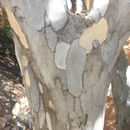More info for the terms:
fire management,
forest,
frequency,
fuel,
fuel moisture,
graminoid,
herbaceous,
root crown,
severity,
shrub,
shrubs,
top-killManagers use fire in combination with mechanical methods to control and
remove brush from grasslands. On a loam prairie site in Goliad County,
Texas persimmon decreased as much as 68 percent with mechanical
treatment combinations followed by 2 consecutive years of August fires.
Treatment combinations included roller chopping followed by 2
consecutive years of shredding, and roller chopping, shredding, and
herbicide spraying while shredding [
15].
On the Welder Wildlife Refuge in southern Texas, mechanical brush
removal treatments followed by fall fire 2 years later was applied to a
chaparral-bristlegrass community. Fires were more effective at brush
control if the area had been pretreated with mechanical brush removal.
Plots with mechanical removal (chopped, scalped with a bulldozer, or
shredded with a rotary mower) burned uniformly because of available
fuel. In plots with no mechanical pretreatment, fire carried in the
grass and into small brush clumps, but large brush mottes remained
unburned. On burned plots, 10 percent of Texas persimmon, mostly small
plants, were completely killed; the remainder were top-killed but
sprouted from the root crown. At postfire year 1, Texas persimmon
average percent frequency for unburned (but mechanically treated) plots
was 19 percent and for pretreated burned plots was 10 percent [
8].
FIRE CASE STUDY
SPECIES: Diospyros texana
FIRE CASE STUDY CITATION : Carey, Jennifer H., compiler. 1994. Fire temperatures and the effect of burning on
Texas persimmon on the Welder Wildlife Refuge, south Texas. In: Diospyros
texana. In: Fire Effects Information System, [Online]. U.S. Department of
Agriculture, Forest Service, Rocky Mountain Research Station, Fire Sciences
Laboratory (Producer). Available: https://www.fs.fed.us
/database/feis/ [
var months = new Array(12);
months[0] = "January";
months[1] = "February";
months[2] = "March";
months[3] = "April";
months[4] = "May";
months[5] = "June";
months[6] = "July";
months[7] = "August";
months[8] = "September";
months[9] = "October";
months[10] = "November";
months[11] = "December";
var date = new Date();
var year = date.getFullYear();
var month = date.getMonth();
var day = date.getDate();
document.write(year+", "+months[month]+" "+day);
].
REFERENCE : White, Richard S. 1969. Fire temperatures and the effect of burning on
south Texas brush communities. Lubbock, TX: Texas Technological College.
74 p. Thesis. [
46].
SEASON/SEVERITY CLASSIFICATION : Spring/variable severity
STUDY LOCATION : The study was conducted on the Welder Wildlife Refuge in San Patricio
County, Texas, about 20 miles (32 km) north of Corpus Christi.
PREFIRE VEGETATIVE COMMUNITY : Two plant communities are present in the study area:
chaparral-bristlegrass (Setaria spp.) and honey mesquite (Prosopis
glandulosa var. glandulosa)-buffalograss (Buchloe dactyloides).
Collectively, these communities are dominated by leguminous shrubs
interspersed with grasses. Honey mesquite and huisache (Acacia
farnesiana) dominate the shrub layer, and seacoast bluestem
(Schizachyrium scoparium var. littoralis) is the most abundant
graminoid.
TARGET SPECIES PHENOLOGICAL STATE : At the time of the fire, Texas persimmon (Diospyros texana) was
semidormant. A few old leaves were present on some plants. Two weeks
after the fire, leaf buds began to open on unburned plots.
SITE DESCRIPTION : The study is located on the Gulf Coastal Plain so presumably the
topography is flat or rolling. The soil is a clay in the Vertisols
order. The climate is subtropical; rainfall averages 30 inches (760 mm)
a year.
FIRE DESCRIPTION : The 10-acre (4 ha) study site was divided into four subplots; one was
burned on March 8 and the remaining three on March 12. Fire weather and
site conditions for the March 8 fire were as follows: air temperature
60 degrees Fahrenheit (16 deg C), relative humidity 90 percent, wind
velocity 10 miles per hour (16 k/h), soil moisture 40 percent, and
herbaceous fuel moisture 9 percent. Conditions for the March 12 fire
were as follows: air temperature 55 degrees Fahrenheit (13 deg C),
relative humidity 45 percent, wind velocity 20 to 30 miles per hour
(32-48 k/h), soil moisture 37 percent, and herbaceous fuel moisture 7
percent. Both fires were wind driven. The March 12 fire was hotter
than the March 8 fire primarily because of lower humidity and higher
wind velocity.
Forty to fifty percent of the study site did not burn. Fire carried
well through the tall seacoast bluestem but burned poorly in areas
dominated by shorter grasses. Surface temperatures during the fires
were extremely variable. Maximum surface temperatures ranged from 480
to 1,350 degrees Fahrenheit (249-732 deg C). Temperature showed a weak
(P less than 0.10) correlation with fuel quantity. Flame height was about 7 feet
(2.1 m) on March 8 and 8 feet (2.4 m) on March 12.
FIRE EFFECTS ON TARGET SPECIES : Although 50 Texas persimmon plants were originally tagged for postfire
study, only 17 plants were analyzed because of incomplete burning.
Percent partial and complete top-kill of Texas persimmon at different
fuel loads follows:
Fuel Partial Top-kill Complete Top-kill
(lbs/acre) (percent) (percent)
0-2,000 67 33
2,000-4,000 25 75
> 4,000 0 100
Regardless of fuel load, no Texas persimmon was completely killed.
Fire damage to Texas persimmon was inversely related to its size when
fuel loads were less than 2,000 lbs per acre. Of six individuals less
than 1 inch (2.5 cm) in basal diameter, three individuals were partially
top-killed and three were completely top-killed. Of six individuals
greater than 1 inch (2.5 cm) in basal diameter, five were partially
top-killed and only one was completely top-killed.
FIRE MANAGEMENT IMPLICATIONS : Spring fire was effective at top-killing Texas persimmon, but did not
result in mortality. For useful brush control, fire must be applied a
number of times over a period of years. To achieve maximum results,
fire should be prescribed when the plants are young and the fuel load is
high.

